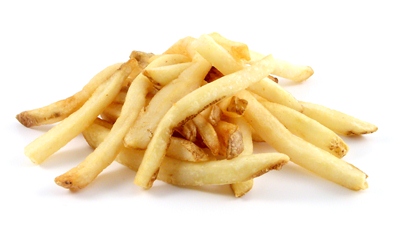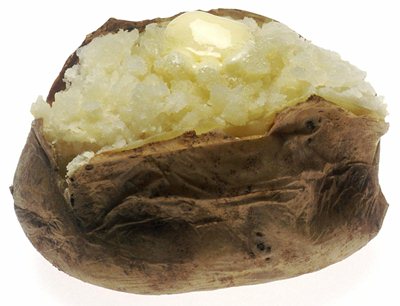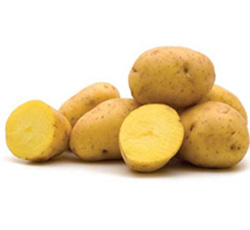
The potato is a starchy, tuberous crop from the perennial Solanum tuberosum of the Solanaceae family (also known as the nightshades). The word potato may refer to the plant itself as well as the edible tuber.
In the region of the Andes, there are some other closely related cultivated potato species. Potatoes were first introduced outside the Andes region four centuries ago, and have become an integral part of much of the world's cuisine. It is the world's fourth-largest food crop, following rice, wheat, and maize. Long-term storage of potatoes requires specialised care in cold warehouses.
Wild potato species occur throughout the Americas, from the United States to Uruguay. The potato was originally believed to have been domesticated independently in multiple locations, but later genetic testing of the wide variety of cultivars and wild species proved a single origin for potatoes in the area of present-day southern Peru (from a species in the Solanum brevicaule complex), where they were domesticated 7,000–10,000 years ago. Following centuries of selective breeding, there are now over a thousand different types of potatoes. Of these subspecies, a variety that at one point grew in the Chiloé Archipelago (the potato's south-central Chilean sub-center of origin) left its germplasm on over 99% of the cultivated potatoes worldwide.
Following the Spanish conquest of the Inca Empire, the Spanish introduced the potato to Europe in the second half of the 16th century. The staple was subsequently conveyed by European mariners to territories and ports throughout the world. The potato was slow to be adopted by distrustful European farmers, but soon enough it became an important food staple and field crop that played a major role in the European 19th century population boom. However, lack of genetic diversity, due to the very limited number of varieties initially introduced, left the crop vulnerable to disease. In 1845, a plant disease known as late blight, caused by the fungus-like oomycete Phytophthora infestans, spread rapidly through the poorer communities of western Ireland, resulting in the crop failures that led to the Great Irish Famine. Nonetheless, thousands of varieties persist in the Andes, where over 100 cultivars might be found in a single valley, and a dozen or more might be maintained by a single agricultural household.
The annual diet of an average global citizen in the first decade of the 21st century included about 33 kg (73 lb) of potato. However, the local importance of potato is extremely variable and rapidly changing. It remains an essential crop in Europe (especially eastern and central Europe), where per capita production is still the highest in the world, but the most rapid expansion over the past few decades has occurred in southern and eastern Asia. China is now the world's largest potato-producing country, and nearly a third of the world's potatoes are harvested in China and India.
 The English word potato comes from Spanish patata (the name used in Spain). The Spanish Royal Academy says the Spanish word is a compound of the Taino batata (sweet potato) and the Quechua papa (potato). The name potato originally referred to a type of sweet potato rather than the other way around, although there is actually no close relationship between the two plants. The English confused the two plants one for the other. In many of the chronicles detailing agriculture and plants, no distinction is made between the two. The 16th-century English herbalist John Gerard used the terms "bastard potatoes" and "Virginia potatoes" for this species, and referred to sweet potatoes as "common potatoes". Potatoes are occasionally referred to as "Irish potatoes" or "white potatoes" in the United States, to distinguish them from sweet potatoes.
The English word potato comes from Spanish patata (the name used in Spain). The Spanish Royal Academy says the Spanish word is a compound of the Taino batata (sweet potato) and the Quechua papa (potato). The name potato originally referred to a type of sweet potato rather than the other way around, although there is actually no close relationship between the two plants. The English confused the two plants one for the other. In many of the chronicles detailing agriculture and plants, no distinction is made between the two. The 16th-century English herbalist John Gerard used the terms "bastard potatoes" and "Virginia potatoes" for this species, and referred to sweet potatoes as "common potatoes". Potatoes are occasionally referred to as "Irish potatoes" or "white potatoes" in the United States, to distinguish them from sweet potatoes.
Potato plants are herbaceous perennials that grow about 60 cm (24 in) high, depending on variety, the culms dying back after flowering. They bear white, pink, red, blue, or purple flowers with yellow stamens. In general, the tubers of varieties with white flowers have white skins, while those of varieties with colored flowers tend to have pinkish skins. Potatoes are cross-pollinated mostly by insects, including bumblebees, which carry pollen from other potato plants, but a substantial amount of self-fertilizing occurs as well. Tubers form in response to decreasing day length, although this tendency has been minimized in commercial varieties.
Nutrition
Potato, raw, with skinNutritional value per 100 g (3.5 oz)
Energy 321 kJ (77 kcal)
Carbohydrates 19 g
- Starch 15 g
- Dietary fiber 2.2 g
Fat 0.1 g
Protein 2 g
Water 75 g
Thiamine (Vit. B1) 0.08 mg (6%)
Riboflavin (Vit. B2) 0.03 mg (2%)
Niacin (Vit. B3) 1.1 mg (7%)
Vitamin B6 0.25 mg (19%)
Vitamin C 20 mg (33%)
Calcium 12 mg (1%)
Iron 1.8 mg (14%)
Magnesium 23 mg (6%)
Phosphorus 57 mg (8%)
Potassium 421 mg (9%)
Sodium 6 mg (0%)
Percentages are relative to US recommendations for adults.
The potato contains vitamins and minerals, as well as an assortment of phytochemicals, such as carotenoids and natural phenols. Chlorogenic acid constitutes up to 90% of the potato tuber natural phenols. Others found in potatoes are 4-O-caffeoylquinic (crypto-chlorogenic acid), 5-O-caffeoylquinic (neo-chlorogenic acid), 3,4-dicaffeoylquinic and 3,5-dicaffeoylquinic acids. A medium-size 150 g (5.3 oz) potato with the skin provides 27 mg of vitamin C (45% of the Daily Value (DV)), 620 mg of potassium (18% of DV), 0.2 mg vitamin B6 (10% of DV) and trace amounts of thiamin, riboflavin, folate, niacin, magnesium, phosphorus, iron, and zinc. The fiber content of a potato with skin (2 g) is equivalent to that of many whole grain breads, pastas, and cereals.
In terms of nutrition, the potato is best known for its carbohydrate content (approximately 26 grams in a medium potato). The predominant form of this carbohydrate is starch. A small but significant portion of this starch is resistant to digestion by enzymes in the stomach and small intestine, and so reaches the large intestine essentially intact. This resistant starch is considered to have similar physiological effects and health benefits as fiber: It provides bulk, offers protection against colon cancer, improves glucose tolerance and insulin sensitivity, lowers plasma cholesterol and triglyceride concentrations, increases satiety, and possibly even reduces fat storage. The amount of resistant starch in potatoes depends much on preparation methods. Cooking and then cooling potatoes significantly increases resistant starch. For example, cooked potato starch contains about 7% resistant starch, which increases to about 13% upon cooling.
The cooking method used can significantly impact the nutrient availability of the potato.
Potatoes are often broadly classified as high on the glycemic index (GI) and so are often excluded from the diets of individuals trying to follow a low-GI diet. In fact, the GI of potatoes can vary considerably depending on type (such as red, russet, white, or Prince Edward), origin (where it was grown), preparation methods (i.e., cooking method, whether it is eaten hot or cold, whether it is mashed or cubed or consumed whole, etc.), and with what it is consumed (i.e., the addition of various high-fat or high-protein toppings). Potatoes are not considered by the NHS as counting towards the five portions of fruit and vegetables diet.
The health benefits of potato
Weight Gain
Potatoes are mounds of carbohydrates and contain little proteins too. This makes it an ideal diet for those lean and thins who desperately want to put on weight. The vitamins like vitamin-C and B-complex also help in proper absorption of this carbohydrate. That is why they make an inevitable part of the diet of Sumo Wrestlers.
Digestion
Since potatoes predominantly contain carbohydrates, they are easy to digest and facilitate digestion. This property makes them a good diet for patients, babies and those who cannot digest hard food but need energy. But you must remember that eating too much of potatoes regularly may cause acidity in the long run. Potatoes also contain considerable amount of fiber or roughage, more in raw potatoes and cold ones than boiled or hot ones.
Skin Care
Vitamin-C and B-complex and minerals like potassium, magnesium, phosphorus and zinc are good for the skin. Apart from that, pulp obtained from crushed raw potatoes, mixed with honey, can serve as excellent skin and face packs. This helps even curing pimples and spots on the skin. Again, this pulp, if applied externally on burns, gives a quick relief and heals fast. Smashed potatoes, even water in which potatoes are washed, are very good for softening and cleaning skin, especially around elbows, back of the palms etc.
Scurvy
The vitamin-C present in potatoes can help prevent this dreaded deficiency disease, caused due to lack of vitamin-C. It is characterized by cracked lip corners, spongy and bleeding gums, frequent viral infections like cold etc.
Rheumatism: There are two aspects of this factor. Vitamins, calcium and magnesium in potatoes help giving relief in rheumatism. Water obtained from boiling potato gives relief in rheumatism. But due to high starch or carbohydrate content it tends to increase body weight which may have adverse effects on rheumatic people.
Inflammation
Potato is very effective in inflammation, internal or external. Since it is soft, easy digestible and has a lot of vitamin-C (very good anti-oxidant and repairs wears and tears), potassium and vitamin-B6, among others, it relieves inflammation of intestines and the digestive system. It is very good diet for those who have mouth ulcers. Again, raw smashed potato can be applied to relieve external inflammation, burns etc.
High Blood Pressure
Since high blood pressure is caused due to a number of reasons, including diabetes, tension, indigestion, nature of food and many such, different are the cures. Potato can be used to relieve High Blood Pressure due to tension, indigestion etc. due to abundance of vitamin-C and B in it, but should be avoided if it is due to diabetes. The fiber present in it is helpful in lowering cholesterol and improves functioning of insulin in the body, which aids to lowering of blood pressure, since there is a direct relation between the blood pressure and the glucose level in the blood and insulin regulates this glucose level.
Brain Function
Proper functioning of the brain depends largely on the glucose level, oxygen supply, some members of the vitamin-B complex and some hormones, amino acids and fatty acids like omega-3 fatty acids. Potatoes cater to almost all the needs mentioned above. They are high in carbohydrates and thus maintain good level of glucose in the blood which does not let brain fatigue creep in and keeps the brain active and alert. Next is oxygen which is carried to the brain by the haemoglobin in the blood and whose main constituent is iron. Potato contains iron too and thus aids to this function also. Next is the turn of vitamin-B complex. Here again, potato is rich in vitamin-B6 and contains traces of other members of this complex. In addition, it contains certain other elements like phosphorus and zinc which are good for brain too.
Heart Diseases
Apart from the vitamins (B-complex, C), minerals and roughage, potatoes also contain certain substances called Carotenoids (lutein, zeaxanthin etc.) which are beneficial for heart and other internal organs. But again, since it raises the glucose level in the blood and over intake may cause obesity, which in turn can put a lot of pressure on your heart; hence it is not recommended for obese or diabetic people.
Kidney Stones
Kidney Stones, also known as Renal Calculi, are caused mainly due to raised level of uric acid in blood. In such cases, high proteins should be avoided, particularly animal proteins such as meat, turkey, shrimps, sea fishes, eggs, milk etc. as well as spinach, raw plantain, black grams and certain beans, which drastically increase the level of uric acid in blood. Iron and calcium also help form the stone. Potato is rich in both of these and normally seems not fit from this point of view. But it is very rich in magnesium which resists accumulation or deposition of calcium (calcification) in the kidney and other tissues, thereby proving beneficial for treatment of renal calculi.
Diarrhea
It is an excellent energy-rich diet for those suffering from diarrhea, since it is very easy to digest as well as contains mild roughage. But an over intake may cause diarrhea due to excess ingestion of starch.
Other Benefits and Cautions
Juice of potato is a good treatment for burns, bruises, sprains, skin problems, ulcers, effect of narcotics, cancer of prostrate and uterus and formation of cysts or tumors. On the other hand, some care also needs to be taken while eating potatoes. Green potatoes are poisonous, and so are potato leaves and fruits, as they contain alkaloids like solanine, chaconine and arsenic whose overdose may prove fatal. Moreover, the glycemic index (in simple words, the energy or sugar content) of potatoes is very high (above 80) and so obese, diabetic and those who are slimming down should avoid eating potatoes. If eaten, potatoes are better baked than raw or fried.
Heartburn
Many people would agree that heartburn is one of the most miserable feelings one can experience. And the timing doesn't help either... Right after a nice, big, delicious meal when all you want to do is sit back and relax (it never fails...)
Right after a nice, big, delicious meal when all you want to do is sit back and relax (it never fails...)
Many over-the-counter drugs provide temporary relief, but the next time it hits, it comes back just as strong. OTC drugs help at easing the pain, but don't help in curing the problem.
People as far back as the early Native Americans have been resorting to a more natural aid in fighting heartburn- Potatoes!
The Native Americans found that by drinking potato juice mixed with water, they could cure most digestive problems, including heartburn.
"After the first few treatments, you should notice a sharp decline in the severity and frequency of heartburn disturbances. Within a few months, you may discover that you rarely suffer from heartburn attacks anymore. In no time at all, you will only be disturbed with heartburn on rare occasions."
It is also a safe prevention of heartburn during pregnancy! The list of benefits of this organic vegetable juice goes on and on!
Preparation
Potatoes should be thoroughly washed with clean tap water and scrubbed lightly before preparation. Any sprouts or eyes growing from the potato should be cut out. The skin can be removed or left on depending on use.
Common methods of preparation include boiling, baking, microwaving, mashing, frying and grilling. Consuming baked and grilled potatoes with the skin left on provides the most nutrients.
The only requirement involves cooking to swell the starch granules. Most potato dishes are served hot, but some are first cooked, then served cold, notably potato salad and potato chips/crisps.
Common dishes are: mashed potatoes, which are first boiled (usually peeled), and then mashed with milk or yogurt and butter; whole baked potatoes; boiled or steamed potatoes; French-fried potatoes or chips; cut into cubes and roasted; scalloped, diced, or sliced and fried (home fries); grated into small thin strips and fried (hash browns); grated and formed into dumplings, Rösti or potato pancakes. Unlike many foods, potatoes can also be easily cooked in a microwave oven and still retain nearly all of their nutritional value, provided they are covered in ventilated plastic wrap to prevent moisture from escaping; this method produces a meal very similar to a steamed potato, while retaining the appearance of a conventionally baked potato. Potato chunks also commonly appear as a stew ingredient.
Potatoes are boiled between 10 and 25 minutes, depending on size and type, to become soft.
![]()
Disclaimer: This website is for information purposes only. By providing the information contained herein we are not diagnosing, treating, curing, mitigating, or preventing any type of disease or medical condition. Before beginning any type of natural, integrative or conventional treatment regime, it is advisible to seek the advice of a licensed healthcare professional.



























